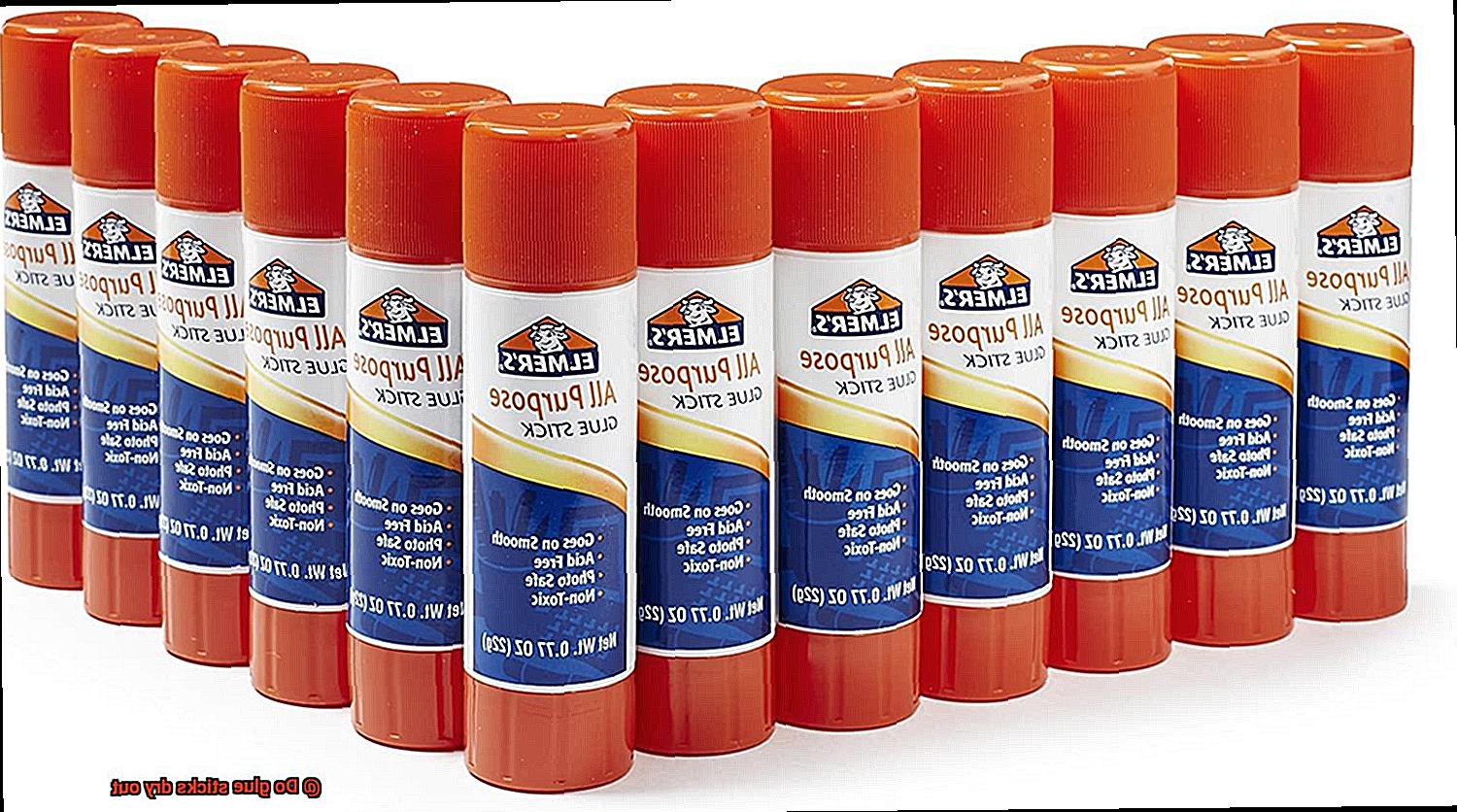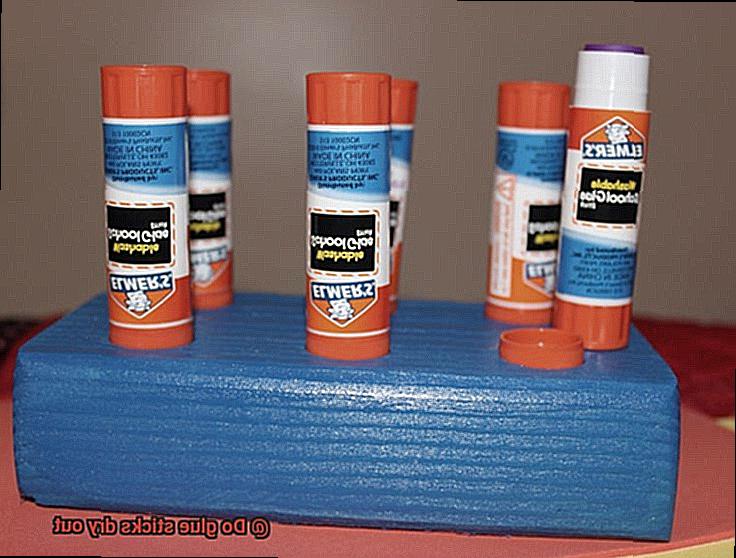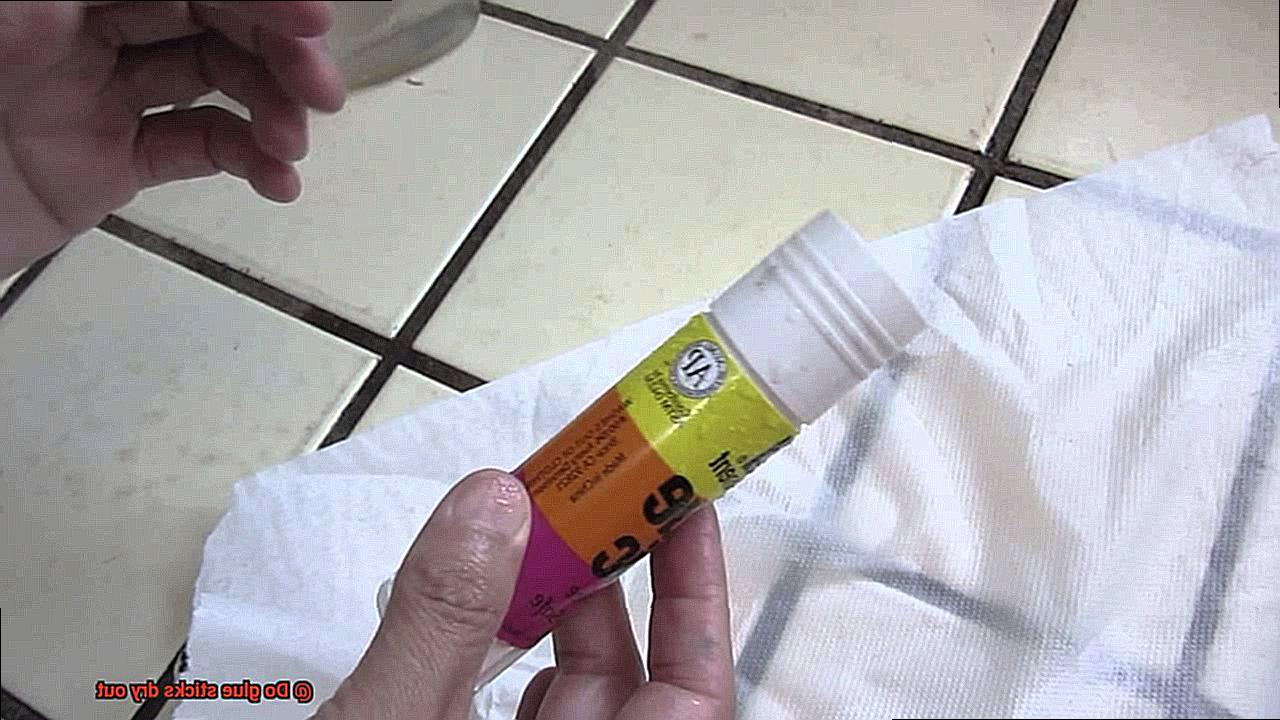Are you a glue stick aficionado? Whether you’re a student, teacher, or DIY enthusiast, chances are you’ve used these handy little sticks at some point. But have you ever wondered if they can dry out? The answer is yes, but that’s just the tip of the iceberg.
Glue sticks are an excellent alternative to their liquid counterparts – they’re less messy and easier to handle. However, this convenience comes with a catch: glue sticks can dry out over time. Whether it’s because you forgot to put the cap back on or simply due to age, dried-out glue sticks can be frustrating.

So what happens when a glue stick dries out? Is it still usable or is it destined for the trash bin? And how can you avoid this problem altogether?
Don’t fret – we’ve got your back. In this post, we’ll explore everything there is to know about glue stick drying. We’ll delve into the science behind it, teach you how to tell if your glue stick has dried out, and offer tips for preventing it from happening in the first place.
So, sit tight and get ready to become a glue stick expert.
Do Glue Sticks Dry Out?
Contents
- 1 Do Glue Sticks Dry Out?
- 2 What Causes Glue Sticks to Dry Out?
- 3 How to Store Glue Sticks Properly
- 4 Tips for Reviving Dried-Out Glue Sticks
- 5 What Happens if You Add Too Much Water to a Dried-Out Glue Stick?
- 6 Benefits of Using Glue Sticks Over Other Adhesives
- 7 Different Types of Glue Sticks Available
- 8 Conclusion
If you’re a fan of glue sticks, you may be wondering if they dry out over time. The answer is yes, but there’s more to it than that. Let’s explore this question further.
Firstly, the storage conditions of your glue stick will determine whether or not it dries out. Leaving the cap off or exposing it to air for extended periods can cause the moisture in the glue to evaporate, leaving it dry and unusable. To avoid this issue, always replace the cap after use and store your glue stick in a cool, dry place away from direct sunlight and heat sources.
Another factor that can contribute to glue sticks drying out is age. Like many products, glue sticks have an expiration date and can lose their effectiveness over time. Before using an older glue stick, check the expiration date to ensure that it’s still usable.
It’s worth noting that not all glue sticks are created equal. Some brands may be more prone to drying out due to differences in their formulations. Choosing a high-quality brand and reading reviews before purchasing can help you avoid this issue altogether.
If you find that your glue stick has already dried out, there are a few things you can do to revive it. Try warming up the glue stick by rubbing it between your hands or placing it in warm water for a few minutes. This can help soften the glue and make it easier to apply. Alternatively, you can add a small amount of water to the glue stick to make it more pliable, but be careful not to add too much as this can dilute the adhesive and reduce its bonding strength.
What Causes Glue Sticks to Dry Out?
They are easy to use, mess-free, and offer a strong bond. However, it’s not uncommon to find them dried out and unusable when you need them the most. So, what causes glue sticks to dry out?
The primary reason for glue sticks drying out is exposure to air. It’s like leaving a wet towel out in the open air – it will eventually dry out. Similarly, when the cap is left off or closed loosely, air enters the tube and dries out the glue inside. Therefore, always remember to replace the cap tightly after use and store your glue stick in a cool, dry place.
Temperature changes can also cause glue sticks to dry out. Extreme temperatures can cause the glue to expand and contract, creating tiny cracks or holes in the glue stick. This allows air to penetrate and dry out the glue from the inside. Therefore, avoid storing your glue stick in areas with extreme temperatures such as near a heater or in direct sunlight.
Using old or expired glue sticks can also lead to them drying out faster. Glue sticks have a shelf life of about two years, after which they may start to lose their adhesive properties and dry out. Keep an eye on expiration dates and replace your glue stick accordingly.
Lastly, improper use can cause glue sticks to dry out quickly. Applying too much pressure while using a glue stick or using it on a porous surface can cause the glue not to adhere properly, leading to faster drying times. Always use the correct application method for your project.
How to Store Glue Sticks Properly
Fear not, proper storage is the key to ensuring that your glue sticks remain usable and don’t dry out. Here are some tips to help you store your glue sticks properly.
Cool and Dry Storage:
The first and most crucial tip is to store your glue sticks in a cool, dry place. Heat and humidity can cause the glue to melt and become unusable. Therefore, avoid storing glue sticks in direct sunlight or near sources of heat such as radiators or hot appliances. A cool, dry closet or drawer is an ideal storage spot for your glue sticks.
Packaging:
Glue sticks typically come in plastic tubes that are designed to keep the glue fresh and prevent it from drying out. Therefore, it is important not to remove the glue from its original packaging, as this can expose it to air and moisture. Leaving the glue stick in its original packaging will also make it easier to find when you need it.
Upright Storage:

Keeping your glue sticks upright is another essential factor to consider. This helps prevent the glue from settling at the bottom of the tube, which can make it difficult to apply evenly. Additionally, keeping the glue sticks upright can also prevent them from becoming deformed or misshapen, which can make them difficult to use. A simple solution is to use a small cup or container to hold your glue sticks upright.
Airtight Containers:
Using an airtight container or bag is recommended when storing your glue sticks. This will prevent air from getting in and causing the glue to dry out. A ziplock bag or plastic container with a tight-fitting lid can work well for this purpose. Make sure that the container is clean and dry before storing your glue sticks.

Labeling:
It’s a great idea to label your glue sticks with the date of purchase. This can help you keep track of how long you have had them and ensure that you use the oldest ones first. Generally, most glue sticks have a shelf life of around two years, but this can vary depending on the brand and storage conditions. Use a permanent marker to write the purchase date on the glue stick or its packaging.
Tips for Reviving Dried-Out Glue Sticks
Glue sticks are a go-to adhesive for many people because they are easy to use, clean, and budget-friendly. However, glue sticks can dry out over time, making them unusable for future projects. But don’t throw them away just yet. With some creativity and effort, you can revive dried-out glue sticks using the following tips and tricks.
Heat it up
One of the most effective ways to soften a dried-out glue stick is to heat it up. You can use a hairdryer or hold the glue stick in a bowl of hot water for several minutes. The heat will melt the adhesive and make it easier to apply. Once the glue stick has softened, you can push it through a glue gun or put it directly on your project.
Add moisture
Another way to revive a dried-out glue stick is to add some moisture back into it. You can do this by placing the glue stick in a sealed plastic bag with a slightly damp paper towel or sponge for a few hours. This will help to rehydrate the glue and make it more workable.
Scrape off the top layer
If your glue stick is only slightly dried out, you can try scraping off the top layer with a knife or scissors. This will expose the fresh adhesive underneath and allow you to use the glue stick once again.
Store properly
To prevent your glue sticks from drying out, store them properly in a cool, dry place away from direct sunlight and heat sources. Also, make sure to keep them sealed when not in use.
Test before using
Before using your revived glue stick on a project, test it on a scrap piece of paper or cardboard. This will ensure that the adhesive is strong enough for your project and that it won’t fall apart.
It’s important to note that while these tips can help revive dried-out glue sticks, they may not work in all cases. If your glue stick is too far gone, it may be best to replace it with a new one. However, by using these tips and tricks, you can potentially salvage your dried-out glue sticks and save yourself some money in the process.
What Happens if You Add Too Much Water to a Dried-Out Glue Stick?
Let me break down the reasons why:
Firstly, adding too much water can render the glue stick useless. The adhesive properties of the glue may disappear entirely, making it unsuitable for any project. You may even end up with a moldy or contaminated glue stick due to excess moisture. Nobody wants that.
Secondly, adding too much water to a dried-out glue stick can result in a sticky mess. The glue may become too runny and spill all over your workspace and project. This could potentially cause damage or ruin your work completely. Cleaning up excess glue is no picnic either, especially once it has dried.
To avoid these issues, it’s best to store your glue sticks in a cool and dry place to prevent them from drying out in the first place. If your glue stick does dry out, don’t attempt to salvage it by adding water. It’s better to replace it than risk ruining your project or workspace.
Benefits of Using Glue Sticks Over Other Adhesives
Fear not, for glue sticks are here to save the day. As an expert on the subject, I can confidently say that there are numerous benefits to using glue sticks over other adhesives.
First and foremost, glue sticks are incredibly easy to use and mess-free. Unlike liquid glue, there’s no need for brushes or tools that can create a mess or be time-consuming. With a simple twist of the container, you can easily apply the adhesive directly onto your surface without any fuss.
Another significant advantage of using glue sticks is their safety. They’re non-toxic and don’t emit any harmful fumes, making them ideal for use in schools, homes, and other environments where safety is a top priority. This ensures peace of mind while working on your projects.
But what really sets glue sticks apart from other adhesives is their ability to create a strong bond that lasts over time. Once dried, the bond is secure and won’t easily come apart, making them perfect for crafting projects, school assignments, and other applications that require a long-lasting bond.
In addition to their strength and convenience, glue sticks are also versatile. They can be used on various surfaces, including paper, cardboard, fabric, and even some plastics. This makes them an all-purpose adhesive suitable for a range of projects.
Different Types of Glue Sticks Available
Glue sticks are a popular choice for bonding materials together due to their convenience, ease of use, and mess-free application. However, not all glue sticks are created equal. There are several different types of glue sticks available on the market, each with its unique characteristics and purposes. Let’s explore five sub-sections in more detail.
Clear Glue Sticks
Clear glue sticks are the most common type of glue stick and ideal for everyday use. They can bond paper, cardboard, foam board, and other lightweight materials. They dry clear and are straightforward to use, making them perfect for school projects or office tasks. Clear glue sticks are also a go-to option when you need an adhesive that won’t be visible after drying.
Colored Glue Sticks
If you’re looking to add a dash of color to your projects, colored glue sticks are an excellent choice. These glue sticks come in a variety of colors and work well on paper, cardboard, and other lightweight materials. They’re perfect for decorating cards or creating colorful collages.
Specialty Glue Sticks
Specialty glue sticks are designed for specific applications like bonding photos or glitter. These glue sticks often have unique properties that make them ideal for their intended use. For example, glitter glue sticks contain small pieces of glitter within the adhesive to add sparkle to your project.
High-Temperature Glue Sticks
High-temperature glue sticks are designed for bonding heavier materials like wood, plastic, and metal. These glue sticks can withstand high temperatures and are ideal for use with hot glue guns. They dry quickly, forming a strong bond between the materials.
Fabric Glue Sticks
Fabric glue sticks are specially formulated to bond fabric without damaging it or leaving any residue. They’re perfect for sewing and crafting projects and can be used to hem clothing or repair tears in fabric. These glue sticks are also ideal for attaching embellishments like sequins or beads to fabric.
Low-Temperature Glue Sticks
Low-temperature glue sticks are designed for use with heat-sensitive materials like foam or delicate fabrics. These glue sticks require a lower heat setting on the glue gun and can prevent damage to these materials during the bonding process. They’re perfect for crafting projects that require a more delicate touch.
DhNsncpt_Cc” >
Conclusion
In conclusion, glue sticks are a game-changer when it comes to crafting and DIY projects. Their mess-free application and convenience make them a go-to for many people. However, like all good things, they do have their limitations. Glue sticks can dry out over time due to exposure to air and temperature changes.
To keep your glue sticks in tip-top shape, it’s essential to store them in a cool and dry place away from direct sunlight and heat sources. Always remember to replace the cap after use and keep them sealed when not in use. But if you find that your glue stick has already dried out, don’t worry. You can revive it by warming it up or adding moisture back into it. However, if it’s beyond repair, replacing it with a new one is the best option.
The market offers different types of glue sticks catering to specific applications such as clear glue sticks for everyday use, colored ones for adding a pop of color to projects, specialty ones for bonding photos or glitter, high-temperature ones for heavier materials like wood or metal, fabric ones for bonding without leaving any residue or damaging the material, and low-temperature ones for heat-sensitive materials.
By following proper storage techniques and choosing the right type of glue stick for your project needs, you can ensure that your adhesive remains usable and effective.






